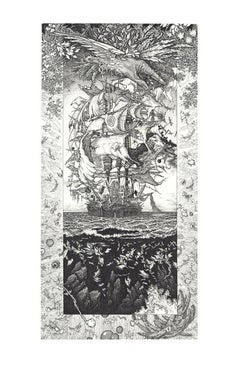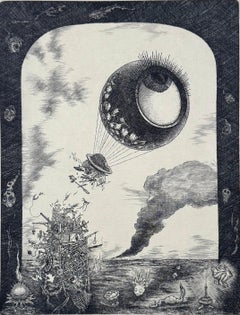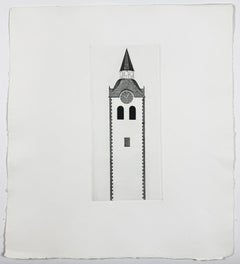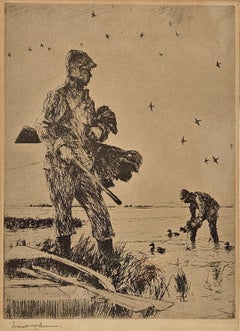David Avery Landscape Prints
American, b. 1952
David Avery has been creating finely detailed black and white etchings in San Francisco for twenty five years. Originally trained as a classical musician, he discovered etching almost by accident in a class at the local community college. After learning the basic techniques, he intently pursued his own course of discovery--being essentially -self taught. Over--the years, he has, developed an exceptional technique and has created a remarkable body of finely wrought miniature etchings and drypoints.
David Avery continues to explore the expressive and technical possibilities inherent in black and white line etching. His work is included in the collections of the Fogg Museum at Harvard University, the New York Public Library, the Achenbach Foundation for the Graphic Arts, the Stanford University Library among others, and has been noted in the New York Times. Even though “black and white doesn’t sell”, he has eschewed the use of color, finding the subtleties and tonalities of black and white most capable of creating the psychological mood that allows his work to be effective.
Public Collections:
Library of Congress
The Fogg Museum of Fine Arts, Harvard University, Cambridge, MA
The Achenbach Foundation for Graphic Arts, San Francisco, CA
Stanford University Library, Special Collections, Stanford, CA
The Turner Print Gallery, California State University, Chico, CA
The Folger Shakespeare Library, Washington, D.C.
St. Mary’s College, Moraga, CA
New York Public Library, New York, NY
San Francisco Public Library, Book Arts and Special Collections Center
Lakeview Museum Permanent Collection, Peoria, IL
Arkansas State University Permanent Collection, AR
Purdue University Galleries
Bradbury Art Museum, Jonesboro, AR
Kellogg University Art Gallery, Pomona, CA
to
2
Overall Width
to
Overall Height
to
1
22
184
169
147
131
2
2
1
1
1
2
2
Artist: David Avery
Concerning The Great Ship MOUR-DE-ZENCLE (19/20)
By David Avery
Located in Palm Springs, CA
Signed and numbered from the edition of 20. Avery's prints often mix elements of myth, legend and history with his own light touch of surrealism.
“MOUR-DE-ZENCLE” is from Alfred Jarry...
Category
2010s Contemporary David Avery Landscape Prints
Materials
Etching
Departure - The Eye Like a Strange Ballon
By David Avery
Located in Palm Springs, CA
Medium: Etching
Year: 2022
Edition Size: 35
Image Size: 8.088 x 6.75 inches
Paper Size: Zerkall Copperplate Cream (yellow) (15" x 12")
An hommage to Odilon Redon's 1878 print Eye-Ba...
Category
2010s David Avery Landscape Prints
Materials
Etching
Related Items
The Church Tower and the Clock by David Hockney Brothers Grimm Fairy Tales
By David Hockney
Located in New York, NY
From David Hockney’s celebrated Six Fairy Tales from the Brothers Grimm portfolio, an image from the story of ‘Fundevogel’. This etching is from the Brothers Grimm tale of ‘Fundevoge...
Category
1960s David Avery Landscape Prints
Materials
Etching, Aquatint
"Winter Wildfowling" Frank Weston Benson, Hunting Scene, Outdoors, Marshes
By Frank Weston Benson
Located in New York, NY
Frank Weston Benson
Winter Wildfowling, 1927
Signed lower left
Etching on paper
Image 8 1/2 x 7 inches
Born in Salem, Massachusetts, a descendant of a long line of sea captains, Benson first studied art at Boston’s Museum School where he became editor of the student magazine. In 1883, Benson enrolled at the Académie Julian in Paris where artists such as Bouguereau, Lefebvre, Constant, Doucet and Boulanger taught students from all over Europe and America. It was Boulanger who gave Benson his highest commendation. “Young man,” he said, “Your career is in your hands . . . you will do very well.” Benson’s parents gave him a present of one thousand dollars a twenty-first birthday and told him to return home when it ran out. The money lasted long enough to provide Benson with two years of schooling in Paris, a summer at the seaside village of Concarneau in Brittany and travel in England.
Upon returning to America, Benson opened a studio on Salem’s Chestnut Street and began painting portraits of family and friends. An oil of his wife, Ellen Perry Peirson, dressed in her wedding gown is representative of this period. It demonstrates not only the academic techniques he learned at the Academie Julian but also his own growing emphasis on the effects of light. And yet, despite all the technical mastery displayed in the work, the painting exudes the warmth that existed between model and artist. More than a likeness, it is a study in serenity. Perhaps it was of a work such as this that Benson was thinking when he said, “The more a painter knows about his subject, the more he studies and understands it, the more the true nature of it is perceived by whoever looks at it, even though it is extremely subtle and not easy to see or understand. A painter must search deeply into the aspects of a subject, must know and understand it thoroughly before he can represent it well.”
Following a brief stint as an instructor at the Portland, Maine, Society of Art, Benson was appointed as instructor of antique drawing at the Museum School in Boston in the spring of l889. Benson’s long association with the school was particularly fruitful. Under the leadership of Edmund Tarbell and Benson the Museum School became a national and internationally recognized institution. The students won numerous prizes, enrollment tripled, a new school building was erected and visiting delegations from other schools sought the secret of their success. Benson cherished his role as teacher and was held in high esteem by his students, many of whom called him “Cher Maitre.” Reminiscing about his long career with the school Benson once said, “I may have taught many students, but it was I who learned the most.”
In 1890, Benson won the Hallgarten Prize at the National Academy in New York. It was the first of a long series of awards, that earning for him the sobriquet “America’s Most Medalled Painter.” In the early years of his career, Benson’s studio works were mostly portraits or paintings of figures set in richly appointed interiors. Young women in white stretch their hands out towards the glow of an unseen fire; girls converse on an antique settee in a room full of objets d’arts; his first daughter, Eleanor, poses with her cat. Works of this sort, together with a steady influx of portrait commissions, earned Benson both renown and financial rewards, yet it was in his outdoor works that gave Benson his greatest pleasure.
In the latter half of the 1890s, Benson summered in Newcastle, on New Hampshire’s short stretch of seacoast. It was here, in 1899, that Benson made his first foray into impressionism with Children in the Woods and The Sisters, the latter a sun-dappled study of his two youngest daughters, Sylvia and Elisabeth.
This painting was one of the first works that Benson hung at an exhibition with nine friends. The resignation of these ten illustrious artists rocked the American art establishment but, the catalogue for their first exhibition was titled, simply, “Ten American Painters.” When, in 1898, the three Bostonians and seven New Yorkers began to exhibit their best work in exquisitely arranged small shows, the group (dubbed by newspapers, “The Ten” ) quickly became known as the American Impressionists, a bow to the style of their French predecessors. The Ten’s annual shows soon became an eagerly awaited part of the annual exhibition calendar and were always well reviewed. Held annually in New York City, the group’s yearly exhibitions usually traveled to Boston and were occasionally seen in other cities. Benson’s association with other members of the group such as Childe Hassam, Thomas Dewing, William Merrit Chase and J. Alden Weir, only reinforced his growing emphasis on the tenets of Impressionism. As he later said to his daughter Eleanor, “I follow the light, where it comes from, where it goes.”
The principles of Impressionism began to dominate Benson’s work by 1901, the year that the Bensons first summered on the island of North Haven in Maine’s Penobscot Bay. His summer home “Wooster Farm,” which they rented and finally bought in 1906, became the setting for some of Benson’s best known work and there, it seemed, he found endless inspiration. Benson’s sparkling plein-air paintings of his children–Eleanor, George, Elisabeth and Sylvia–capture the very essence of summer and have been widely reproduced: In The Hilltop, George and Eleanor watch the sailboat races from the headland near their house.
As a boy, Benson dreamed of being an ornithological illustrator. In mid-life, he returned to the wildfowl and sporting subjects that had remained his lifelong passion. Using etching and lithography, watercolor, oil and wash, Benson portrayed the birds observed since childhood and captured scenes of his hunting and fishing expeditions.
Together with his two brothers-in-law, Benson bought a small hunting retreat on a hill overlooking Cape Cod’s Nauset Marsh. Here, in the late 1890s, he began experimenting with black and white wash drawings. These paintings became so popular that Benson was not able to keep up with the demand. He turned to an art publishing company to have several made into it intaglio prints; twelve wash drawings are known to have been reproduced in this manner. At least two of them were given as gifts to associate members of the Boston Guild of artists, of which Benson was a founding member.
Benson was also an avid fisherman and his salmon fishing expeditions to Canada’s Gaspé Peninsula where one of the high points of his summer. There, in 1921, he began the first in a series of watercolors that would eventually over 500 works.
Benson’s watercolors conveyed the joy and beauty of a sportsman’s life whether in a painting of a hunter setting out decoys, a flock of ducks coming in for a landing or a grouse flushed from cover. The critics favorably compared Benson’s watercolors to those of Homer. “The love of the almost primitive wilderness which appears in many of Homer’s landscapes and the swift, sure touch with which he suggests rather than describes–these also characterize Benson’s work,” one critic wrote. “The solitude of the northern woods is very much like Homer’s.”
Like the wash drawings before them, Benson’s watercolors proved...
Category
1920s Academic David Avery Landscape Prints
Materials
Paper, Etching
Individual Etchings: Notre Dame de Paris
By Salvador Dalí
Located in Santa Monica, CA
Salvador Dali
Individual Etchings: Notre Dame de Paris, Published 1969
Medium: E.A. Copper Etching on Japon
Artwork Size: 20 x 25 in
Framed Size: 33.75 x 28.75 in
This work is...
Category
1960s Surrealist David Avery Landscape Prints
Materials
Etching
A Wolf, Hand-Colored Print From The Early 1800s by Johan Wilhelm Palmstruch
By Johan Wilhelm Palmstruch
Located in Stockholm, SE
Johan Wilhelm Palmstruch (1770-1811) Sweden
Title: A Wolf
hand-coloured print
early 1800s
print dimensions approx 4.33 x 7.08 inches (11 x 18 cm)
frame 11.81 x 15.74 inches (30 ...
Category
Early 19th Century Naturalistic David Avery Landscape Prints
Materials
Etching
$1,000
H 11.82 in W 15.75 in
Meadow-Limited Edition Etching, Signed by Artist
By Russa Graeme
Located in Chesterfield, MI
Limited Edition Etching (125/200). Signed by Artist. Measures 32.75 x 25.5 inches and is unframed. The piece is in Fair/Distressed Condition-discoloration/yellowing primarily in the ...
Category
Late 20th Century David Avery Landscape Prints
Materials
Etching
$320 Sale Price
20% Off
H 32.75 in W 25.5 in
The glass mountain shattered David Hockney Fairy Tales from the Brothers Grimm
By David Hockney
Located in New York, NY
This etching from David Hockney’s celebrated Six Fairy Tales from the Brothers Grimm portfolio depicts the somewhat obscure story Old Rinkrank, which Hockney chose to illustrate beca...
Category
1960s Modern David Avery Landscape Prints
Materials
Etching, Aquatint
Italian Summer, Framed Etching by Michael Chapman
By Michael James Chaplin
Located in Brecon, Powys
Etching from the studio of this acclaimed British Watercolorist.
Good condition. Image 15.5" x 11.5"
English artist Michael Chaplin is a Member of the Royal Watercolor Society, pa...
Category
1990s Realist David Avery Landscape Prints
Materials
Etching
$360 Sale Price
20% Off
H 21.25 in W 17.25 in
Ancient Roman Architecture: Original Framed 18th C. Etching by G. Piranesi
By Giovanni Battista Piranesi
Located in Alamo, CA
"Veduta del Sepolcro della Famiglia Plauzia per la Strada Che Conduce da Roma a Tivoli vicino a Ponte Lugano" from "Le Antichità Romane" (Roman Antiquities), one of the most famous works by Piranesi. "Antichita" illustrates the tombs along the Appian Way...
Category
Early 18th Century Old Masters David Avery Landscape Prints
Materials
Etching, Engraving, Drypoint
$3,100 Sale Price
20% Off
H 24.38 in W 31.75 in D 0.75 in
Resting The Horses
By Olaf Wieghorst
Located in New York, NY
Etching, 1937. Signed by the artist and dated in pencil lower right margin.
A scarce etching by this important American western artist.
Category
1930s American Realist David Avery Landscape Prints
Materials
Etching
The Enchantress with the Baby Rapunzel by David Hockney Brothers Grimm Tales
By David Hockney
Located in New York, NY
From David Hockney’s celebrated Six Fairy Tales from the Brothers Grimm portfolio, an image from the story of Rapunzel. The Enchantress with the baby Rapunzel references a Heironymus...
Category
1960s Modern David Avery Landscape Prints
Materials
Etching, Aquatint
The bell tower by David Hockney (Six Fairy Tales from the Brothers Grimm)
By David Hockney
Located in New York, NY
From David Hockney’s celebrated Six Fairy Tales from the Brothers Grimm portfolio, an image from the story of ‘The boy who left home to learn fear’. Hockney chose this story for its ...
Category
1960s David Avery Landscape Prints
Materials
Etching, Aquatint
$1,500
H 17.75 in W 16 in
Hadrian's Mausoleum, Castel S. Angelo: A Framed 18th Century Etching by Piranesi
By Giovanni Battista Piranesi
Located in Alamo, CA
This large framed 18th century etching by Giovanni Battista Piranesi entitled "Veduta del Mausoleo d'Elio Adriana ora chiamato Castello S. Angelo nella parte opposta alla Facciata de...
Category
1750s Old Masters David Avery Landscape Prints
Materials
Etching
$4,700 Sale Price
20% Off
H 28.88 in W 37.25 in D 1.25 in
David Avery landscape prints for sale on 1stDibs.
Find a wide variety of authentic David Avery landscape prints available for sale on 1stDibs. You can also browse by medium to find art by David Avery in etching and more. Much of the original work by this artist or collective was created during the 21st century and contemporary and is mostly associated with the contemporary style. Not every interior allows for large David Avery landscape prints, so small editions measuring 7 inches across are available. Customers who are interested in this artist might also find the work of Alexis Kandra, Howard Behrens, and Aziz + Cucher. David Avery landscape prints prices can differ depending upon medium, time period and other attributes. On 1stDibs, the price for these items starts at $600 and tops out at $650, while the average work can sell for $625.



